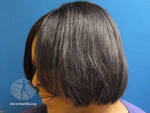
18 Oct Hair Straightening Chemicals May Increase Uterine Cancer Risk
MedicalResearch.com Interview with:

Dr. White
Alexandra J. White, PhD, MSPH
Stadtman Investigator
Epidemiology Branch
National Institute of Environmental Health Sciences
National Institutes of Health
Research Triangle Park, NC
MedicalResearch.com: What is the background for this study? What is the chemical primarily used in hair straighteners?
Response: Hair products such as dye and chemical straighteners contain several different chemicals that may act as carcinogens or endocrine disruptors and thus may be important for cancer risk. Straighteners in particular have been found to include chemicals such as phthalates, parabens, cyclosiloxanes and metals and may release formaldehyde when heated. Previous research has suggested that hair dye and chemical straighteners are related to other hormone-sensitive cancers such as breast and ovarian cancer, but no previous study has considered how they are related to uterine cancer risk.
MedicalResearch.com: What are the main findings? Who is primarily affected?
 Response: Women who reported using straightening products in the past 12 months had an 80% higher relative risk of uterine cancer compared to those who did not use these products. More frequent users of straighteners, those who reported using these products more than 4 times per year, were twice as likely to go on to develop uterine cancer compared to those who did not straightening products. Other hair products, including dyes and permanents/body waves, were not associated with a higher risk of uterine cancer.
Response: Women who reported using straightening products in the past 12 months had an 80% higher relative risk of uterine cancer compared to those who did not use these products. More frequent users of straighteners, those who reported using these products more than 4 times per year, were twice as likely to go on to develop uterine cancer compared to those who did not straightening products. Other hair products, including dyes and permanents/body waves, were not associated with a higher risk of uterine cancer.
MedicalResearch.com: What should readers take away from your report?
Response: These findings suggest that women should consider their use of hair products in light of the fact that the chemicals in straightening products may influence their risk of developing uterine cancer. However, the overall risk is not large and chemical hair products are just one of many factors that may influence a woman’s chances of getting uterine cancer. More research is needed before firm recommendations can be made.
Healthcare experts could consider sharing this evidence with others to inform their decisions regarding hair product use.
MedicalResearch.com: What recommendations do you have for future research as a results of this study?
Response: More research is needed to confirm these findings and to identify the specific constituents in straighteners that may be contributing to this higher risk.
No disclosures.
Citation:
Che-Jung Chang, PhD, Katie M O’Brien, PhD, Alexander P Keil, PhD, Symielle A Gaston, PhD, Chandra L Jackson, PhD, Dale P Sandler, PhD, Alexandra J White, PhD, MSPH, Use of Straighteners and Other Hair Products and Incident Uterine Cancer, JNCI: Journal of the National Cancer Institute, 2022;, djac165, https://doi.org/10.1093/jnci/djac165
The information on MedicalResearch.com is provided for educational purposes only, and is in no way intended to diagnose, cure, or treat any medical or other condition. Always seek the advice of your physician or other qualified health and ask your doctor any questions you may have regarding a medical condition. In addition to all other limitations and disclaimers in this agreement, service provider and its third party providers disclaim any liability or loss in connection with the content provided on this website.
Last Updated on October 18, 2022 by Marie Benz MD FAAD
